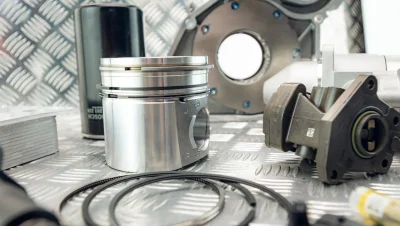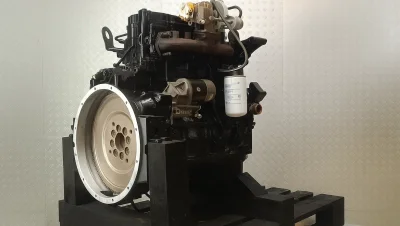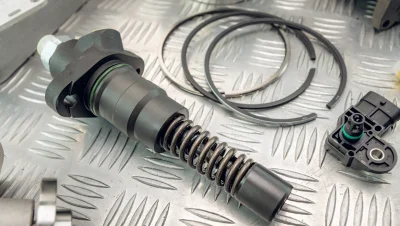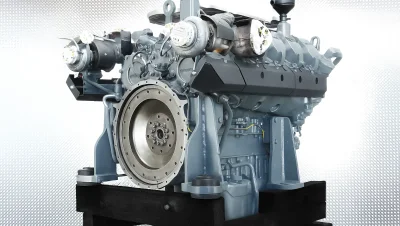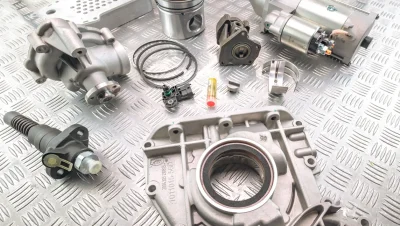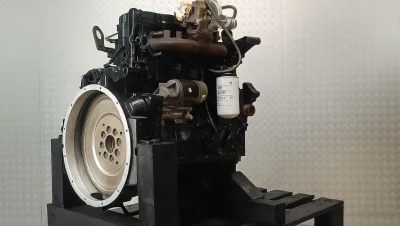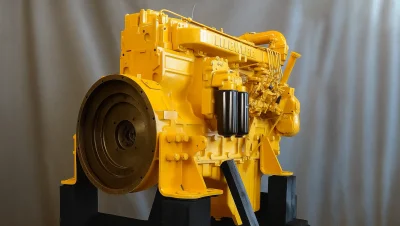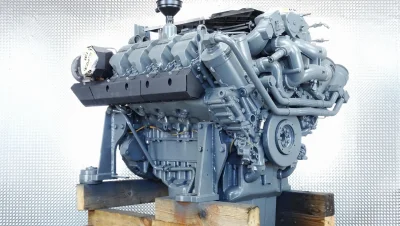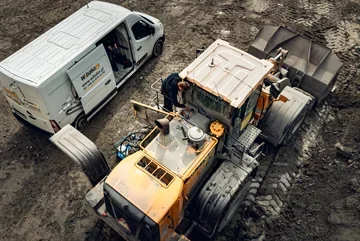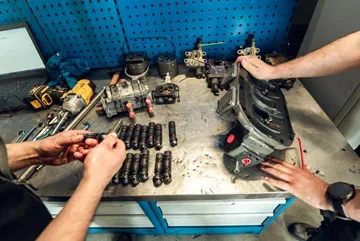Engine overhaul Liebherr D926 TI-E A4 in Liebherr LTM 1400-7.1 mobile crane
The all-terrain mobile crane Liebherr LTM 1400-7.1 is one of the most recognizable designs in the heavy-lift crane class, used on construction sites for the assembly of steel structures, energy works, and heavy industrial operations. The superstructure drive of this model is based on the Liebherr D926 TI-E A4 engine – a unit known for its durability and stable operation in demanding conditions. A superstructure with a damaged engine arrived at our headquarters in Kojszówka, and we began service work after completing a full diagnostic assessment of the machine. The crane was located near Katowice (Silesian Voivodeship), where our mobile service performed the disassembly of the drive and prepared the machine for the transport of the engine to the workshop.
Liebherr D926 series engines are six-cylinder, turbocharged constructions with a mechanical fuel injection system and advanced combustion parameter control. In the LTM 1400-7.1 crane, they are responsible for driving the superstructure, which includes the rotating section along with hydraulic systems responsible for the operation of the boom, supports, and auxiliary systems. The engine damage occurred due to wear of the crankshaft bearings and connecting rods, which began to manifest as a drop in oil pressure and a metallic noise audible during operation at low RPM.
Initial engine diagnostics in the crane
After reporting the fault, our mobile service went to the client near Katowice. The first step was to assess the operation of the superstructure under minimal load. Attention was drawn to: low oil pressure, elevated operating temperatures, and characteristic knocking from the lower part of the block. As part of the basic diagnostics, we measured oil pressure on both cold and warm engines and analyzed oil samples – metal shavings were found in the filter and oil pan, indicating bearing damage.
After confirming our suspicions, we conducted additional diagnostics using an endoscopic camera. This test did not indicate any damage to the pistons or signs of overheating, suggesting that the problem mainly concerned the crank-piston system, especially the bearings. After discussing with the client, it was decided to disassemble the engine and transport it to our facility in Kojszówka, where a full verification was possible under workshop conditions.
Engine disassembly from the Liebherr LTM 1400-7.1 crane
The disassembly of the Liebherr D926 TI-E A4 engine from such a large crane requires adherence to special safety procedures. This process was carried out using a crane provided by the client and with the support of our mobile service. First, the systems were disconnected: cooling, auxiliary hydraulics, fuel supply, intake and exhaust systems, as well as the electrical installation. All wires were labeled and secured to avoid errors during later assembly.
After removing the accessories, we proceeded to unscrew the engine mounts. Each element was coated with an anti-corrosion agent, which facilitated work on the heavily worn unit. After separating the engine from the superstructure frame, it was carefully lifted and placed on a specialized transport pallet, then transported to the WIBAKO headquarters.
Engine verification in the workshop
After disassembling the engine into parts, our earlier suspicion was confirmed: the connecting rod and main bearings were heavily worn, and the crankshaft showed signs of scoring. However, the damage was not severe enough to qualify the shaft for replacement – regeneration in the form of grinding and cleaning of the oil channels was possible.
As part of the verification, we also conducted:
- measurement of the crankshaft, checking for runout and assessing the surface of the journals,
- verification of the connecting rods: measuring twist, alignment, and checking for cracks,
- verification of the engine block for micro-cracks and wear of the sleeves,
- detailed verification of the cylinder head (leak test, checking valve seats, guides, channels),
- testing of the turbocharger (axial and radial play),
- testing of the fuel injection pump at an external specialized facility.
Repair and regeneration process
Regeneration of the crank-piston system
The crank-piston system underwent full regeneration. The crankshaft was ground, cleaned, and prepared for new bearings. The connecting rods underwent full inspection and balancing. The cylinder sleeves were replaced with new ones, and the pistons were selected according to Liebherr specifications with appropriate sets of rings. All connections were tightened using new bolts of the appropriate strength class.
Regeneration of the cylinder head
The Liebherr D926 TI-E A4 engine head underwent machining, replacement of guides, valves, and checking of oil channels. The leak test showed full efficiency after the regeneration was completed. Valve seals were replaced with new ones, and the entire component was prepared for assembly according to the manufacturer's guidelines.
Fuel system and accessories
The injection pump and injectors underwent professional testing. The injectors were regenerated and calibrated, while the injection pump was repaired at a certified facility. The turbocharger received a new CHRA core. The alternator and starter were regenerated, and belts and tensioners were also replaced.
Professional assembly of the engine
After completing all repair processes, the engine was assembled with precise tightening moments and full assembly procedures. Factory specifications from Liebherr and original parts were used. After assembly, the engine was placed on the test stand.
Engine test on the dynamometer
WIBAKO, as one of the few companies in Poland, has a dynamometer adapted for off-highway units with high mass and high torque. The test of the Liebherr D926 TI-E A4 engine lasted over 16 hours, in accordance with our control standard. Initially, the engine operated under a light load of 20-30 percent, which allows for the components to break in after the repair.
After the initial phase, a series of full load tests were conducted, during which all key parameters were monitored: oil pressure, coolant temperature, injection stability, and smoke emissions. The engine achieved full factory parameters and was accepted for installation in the crane.
Engine installation in the crane
The installation was carried out at the machine's work site near Katowice. First, the work station was prepared, the superstructure frame was cleaned, worn rubber elements were replaced, and the air piping, cooling system, and hydraulic hoses were checked. The engine was precisely positioned using the client's crane and then connected to the hydraulic system of the superstructure and the fuel installation.
All filters were replaced, operating fluids were replenished, and the intake installation was checked for leaks. After completing the assembly, we started the engine and conducted a series of tests with the crane operator – the response of the hydraulic systems, stability of revolutions, absence of leaks, and proper operation of the turbocharger were checked.
After the tests were completed, a handover protocol was prepared.
Engine maintenance after repair
The engine is covered by a warranty, and the first service inspection should be performed after 50 operating hours. This is a crucial stage – our mechanics check all connections, the condition of the hoses, the tightness of the systems, and the quality of the unit's operation after the repair. Subsequent inspections are recommended every 250 operating hours or every 3 months.
Where is the Liebherr D926 TI-E A4 engine used?
This engine is primarily found in the superstructures of Liebherr LTM series cranes and in selected industrial machines from the manufacturer. The design is intended for operation in harsh conditions, allowing for many years of use, provided that service is performed according to the manufacturer's schedule.
Summary
The overhaul of the Liebherr D926 TI-E A4 engine in the LTM 1400-7.1 crane was carried out comprehensively – from mobile diagnostics, through full regeneration of the crank-piston system, cylinder head, and accessories, to testing on the dynamometer and installation in the field. As a result, the client received a fully operational engine with factory parameters, ready for further heavy work. We encourage you to contact us – the service of construction machines and diesel engines is the specialization of WIBAKO.
Space for internal links
Here the website operator can add links leading to categories: Liebherr engines, crane service, engine regeneration.
Liebherr Engine Service
Contact us if your machine requires engine repair or regeneration. We offer comprehensive service, engine dynamometer testing, and mobile service team access throughout Poland.



